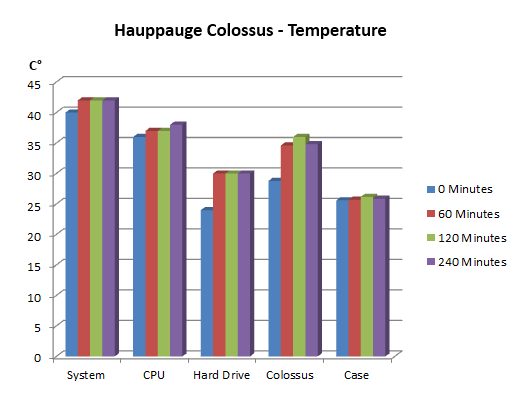Hauppauge Colossus: HD PVR with HDMI Support
by Andrew Van Til on April 14, 2011 5:40 PM EST- Posted in
- HTPC
- Home Theater
- Hauppauge
System Impact
While recording quality is critical, it cannot be the only criteria used to measure a “tuner”. We performed some additional testing to assess the overall impact on a typical HTPC system when using the Colossus. It is more difficult to create a “worst case” environment with a full height card than would be possible if it were low-profile, since we can’t put the Colossus into some of the smaller HTPC cases. However, we did try to simulate use in a hotter chassis by utilizing the highest TDP CPU we had on hand as well as removing all but one of the case fans in the Ahanix D4 used in testing. Here are the specs for our test HTPC; this is hardly state-of-the-art, but it works well for our purposes.
| HTPC System Specifications | |
| Case | Ahanix D4 (Modified for better cooling) |
| Cooling | SilenX 60mm (Exhaust) |
| PSU | Antec EarthWatts 380 |
| CPU | Intel Q6600 (4x2.4GHz 105W TDP) with retail HSF |
| Motherboard | ASUS PK5-Pro |
| RAM | 4GB (2x2GB) ADATA DDR2-800 |
| Storage | 500GB Samsung F1 (7200RPM) |
| GPU | NVIDIA GT 430 |
| Optical | Lite-On iHOS104-04 |
| OS | Windows 7 32-bit |
With our test setup, we measured five temperatures at sixty-minute intervals while recording HD content. The five points we measures are the system (chipset), CPU, hard drive, and case, and the surface temperature of the ViXS encoding chip on the Colossus. System, CPU, and hard drive numbers were captured using SpeedFan, while internal case temperature was measured with a thermometer placed inside the case. We used an infrared thermometer to check the ViXS chip (after briefly removing the top of the case).

As we can see from the graph above the Colossus has almost no thermal impact in its environment, with the only significant gains measured by the hard drive and the card itself—both understandable given that is where the majority of recording load is realized. While temperatures weren’t noticeably impacted, we also checked system power use.
| System Power Draw | ||
| Baseline | Colossus Installed | |
| Idle | 68.5W | 76.1W |
| Recording | N/A | 77.1W |
Taking a look at power usage, the system’s draw was measured at the wall with a P3 Kill-A-Watt EZ P4460. We checked power draw first without the Colossus, then installed it and checked idle and recording power use. I was somewhat surprised by the initial difference (7.6W) after installing the card, but after looking at the results while recording where the delta between the two states is probably due to additional hard drive load it appears that the card does not utilize a low power idle state when not capturing data.

Having had a somewhat rough experience with the original HD PVR’s stability, we put the Colossus through a series of extended stress tests. The good news is that I was not able to reproduce the lockup problems that plagued its predecessor. Unfortunately, the device consistently caused BSODs (Blue Screen of Death) after sixteen to twenty hours of continuous recording. The conditions required to reproduce this issue are uncommon for HTPC DVR use so it is unlikely that most users would experience it. However, it does make the device currently unsuitable for some scenarios like a security system. We notified Hauppauge of the issue and provided a memory dump to help isolate the root cause. Hopefully they can trace the problem and patch it in the near future.










60 Comments
View All Comments